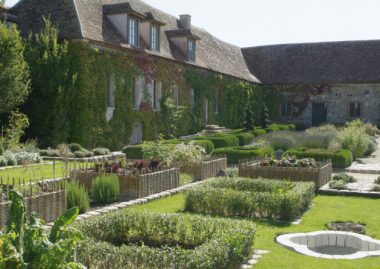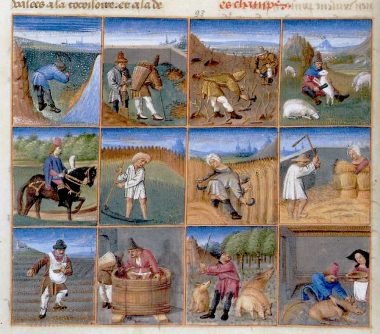Gardens played important role in the Middle Ages. Although plantations of the gardens have taken place much earlier, many sources suggest that garden culture in medieval period came firstly from monasteries. By its rural position, economic functions and architectural form, early monasteries were like a heirs of ancient villa rustica (countryside villa from roman period), with characteristic peristyle yards linking economic, residential and sacral buildings into a unique micro urbanism ensemble. Monte Casino Abbey, founded by St. Benedict in the 6th century in Campania, (not far from Naples), became a prototype of gardens and soon this example expanded throughout Western and Central Europe.



As it can be seen from the 9th century plan preserved in Abbey of Saint Gall in Switzerland, a visionary spot occupy gardens, orchards and vegetable gardens with all the accompanying commercial buildings and venues. Insisting on such content derives from the need for the monastery to be self-contained in the sense of nutrition and to ensure its basic economic survival. Gardens in Middle Ages were not limited only to monasteries, in fact, it spread rapidly on horticulture of the castles. In the beginning, the castle gardens were fulfilled mainly with practical functions by contributing to the survival of a besieged castle crew. This initially modest garden developed (during Late period of Medieval history) into the Early Modern pleasure garden. These princely arrangements improved living conditions in castle. Until about the 12th century, the castles were still very narrow and primitive, so they could hardly accommodate a garden inside. A plant cultivation took place in the early days in center of castle. Only when the castles became larger until the end of 12th century, people cultivated ornamental gardens around of the castle walls. In case when the castle was besieged, castle gardens became important for supplying defenders with food.
Which plants were harvested in medieval gardens ?
Early medieval gardens around the castle contained, among other things, turnip cabbage (kohlrabi), cucumber, hemp, flax, amaranth, lentil, dill, garlic, celery, cabbage, chickpea, carrot, pea, coriander, also parsley, mustard, corn salad (Valerianella locusta), centaury (Centaurium erythraea), purslane, henbane, parsnip, dyer’s chamomile, spurge, Stachys arvensis, Physalis, horse bean (vicia faba) and opium poppy (Papaver somniferum)and there was also a varied horticultural orchard around the castle. Peas and flax must be added to the field crop that spread in the late Middle Ages. Corn salad was not produced by cultivation, this was a wild plant which was collected. Dill, cabbage (cabbage), coriander, fennel, parsley and mustard were all considered as garden plants. Fennel and anise were used in the late Middle Ages for bad breath, besides of course as a vegetable. Myrica gale were used for beer brewing.
More often, however, hops were used for brewing, whereas in Denmark there were mostly common beers made from myrica gale. However, myrica gale or gagel over time proved to be extremely harmful for health and was finally forbidden in the 18th century. In contrast to the monastery and castle gardens, its very little known about the garden of the rural farms in the Middle Ages.



It is questionable whether the monastery and castle gardens can be transferred as models to all other gardens in European medieval cities and villages. All in all, a rural horticulture in the Merovingian period is proven beyond doubt. If there was enough space in gardens people were also planted: grapevines, laurel tree, chestnut, olive tree, plum tree, pear tree. On the medieval manuscript there was name for vegetables as “crumelum” and “legumen”, which probably meant legumes. Furthermore, name referrer in historical sources as “holus” or “olus” probably means cabbage. In addition to chickpeas, people cultivated herbs such as “herbe agrestis”, “herba odorans”, saffron and onions. Since the 10th century, the medieval garden is visibly enriched with new species of plants, particularly decorative. The flowers were rose, lily and the violet, which could also be a wild violet. Roman knowledge and practices of horticulture is very often used by Merovingians. The peasant gardens were usually located in those parts of the yard that immediately adjoined the rear of the farmhouse. Unlike the castle gardens, village gardens were usually open without fences.
Gardens in medieval cities
Within the medieval cities, the greenery was first nurtured with the churches and cemeteries, the residences, and monasteries. Spatial possibilities were much more limited in cities compare to monasteries outside the city walls, so the gardens were noticeably more modest. In the high and late Middle Ages, the importance of inner-city gardens for the supply of the urban population is becoming increasingly apparent. In the 15th century, for example, fruits, berry plants, vegetables, medicinal and ornamental plants, vegetables for oil and nuts were also grown. Even in later stage of medieval history when cities developed and rapidly increased, it was still pretty rural with gardens inside the cities. But in 18th century many cities forbid the animal husbandry within the city walls. Each free spot on the cities was used for vegetable cultivation, and also the fruit and wine growing operated outside the gates of the city. It was not only the poor people who bought their own vegetables, even among the affluent citizens, it was popular to provide themselves with vegetables from their own garden. In the garden design was now not only the benefits in the foreground, now also flowers and plants were planted and cherished for the sake of their beauty. This new garden look came from Italy, the birthplace of the Renaissance.



In the treatise on agronomy De ruralium commodorum libri XII, published in Bologna in 1305, Pietro de’ Crescenzi, describes such a garden for the holiday of “great and middle classes” – le grandi et de le mesane. Acording to Crescenzi this garden divided into quadratic pairs for all types of useful greenery, vegetables and herbs, and with orchards in regular rows. On the basis of Crescenzi’s ideal garden, during the 14th century numerous gardens of the feudal castles and rich urban communes in northern and central Italy were created.
A true gathering anger occurred among the garden lovers, ever rarer, more precious the plants should be in their own garden, everyone tried to outdo his neighbor. For example family Fugger’s in Augsburg in 16th century have particularly distinguished themselves because the citizens of Augsburg complained that the Fugger’s gardens took to much space. In 17th century in Netherlands it was known period called Tulip mania when the tulips were bred as a status symbol in the gardens of rich people, educated bourgeoisie, scientists and aristocrats. During the 30s of the 17th century, the price of bulbs of certain types of tulips grew to a relatively high level before the market in early February 1637 experienced a collapse. In May 1637, tulip bulbs became almost worthless.
A large number of investors in Netherlands in that time remained without their invested assets. Despite this trend of the ornamental garden who started developed within flowers, the vegetable garden remained the main component of any garden. A strict division of the vegetable and ornamental garden did not prevail in the Europe. Of the many medieval gardens, none have been preserved in their original shape so far, so the knowledge of gardens culture is linked almost exclusively to archival material and equally unreliable representations in medieval painting.
Sources:
- Tacker, C., The History of Gardens, London, 1976.
- Chrip, F., Medieval Gardens, London, 1981
- Harvey, J., Medieval Gardens, London, 1981.
- Moser, M., Teyssot, G., The History of Garden Design, London, 1991
- , Der Garten von der Antike bis zum Mittelalter, Mainz, 1995.
